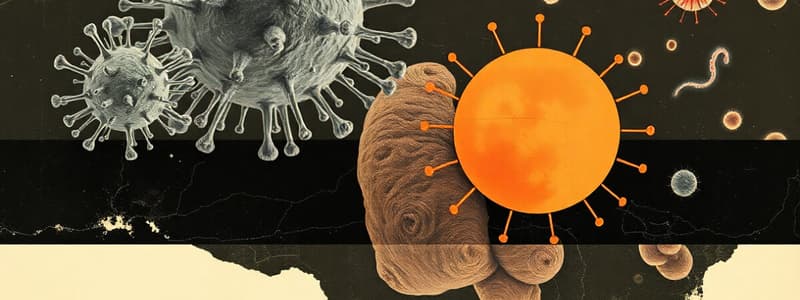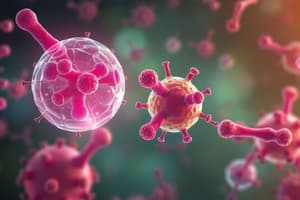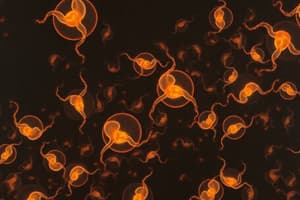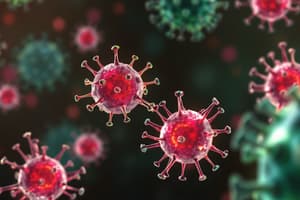Podcast
Questions and Answers
Which characteristic is NOT associated with adaptive immunity?
Which characteristic is NOT associated with adaptive immunity?
- Ability to defend against invaders
- Immediate functionality at birth (correct)
- Recognition of specific invaders
- Memory of past encounters with invaders
What is the role of epitopes in adaptive immunity?
What is the role of epitopes in adaptive immunity?
- They are glycoproteins found on cell membranes.
- They are three-dimensional regions on antigens that are recognized by the immune system. (correct)
- They are the cells that present antigens to lymphocytes.
- They are cytokines released during costimulation.
How do endogenous antigens differ from exogenous antigens in terms of their origin?
How do endogenous antigens differ from exogenous antigens in terms of their origin?
- Endogenous antigens are recognized by T cells, while exogenous antigens are recognized by B cells.
- Endogenous antigens are produced inside a body’s cells, while exogenous antigens are found outside a body’s cells. (correct)
- Endogenous antigens are found outside a body’s cells, while exogenous antigens are produced inside a body’s cells.
- Endogenous antigens are made by our DNA, while exogenous antigens are exclusively produced by viruses.
What is the primary function of Antigen Presenting Cells (APCs) in adaptive immunity?
What is the primary function of Antigen Presenting Cells (APCs) in adaptive immunity?
Which type of MHC protein is typically found on all nucleated cells, but not on red blood cells?
Which type of MHC protein is typically found on all nucleated cells, but not on red blood cells?
How does the T cell receptor (TCR) contribute to the specificity of adaptive immunity?
How does the T cell receptor (TCR) contribute to the specificity of adaptive immunity?
What is the role of costimulation in the activation of T and B cells?
What is the role of costimulation in the activation of T and B cells?
What is the primary function of cytokines, such as interleukins, in the immune response?
What is the primary function of cytokines, such as interleukins, in the immune response?
Cytotoxic T lymphocytes (T8, Tc) eliminate infected cells using what mechanism?
Cytotoxic T lymphocytes (T8, Tc) eliminate infected cells using what mechanism?
What is the role of Helper T lymphocytes (T4, Th) in adaptive immunity?
What is the role of Helper T lymphocytes (T4, Th) in adaptive immunity?
Which statement best describes a function of Regulatory T lymphocytes?
Which statement best describes a function of Regulatory T lymphocytes?
Within the context of cell-mediated immunity, what is the significance of an infected cell displaying MHC I with a foreign epitope?
Within the context of cell-mediated immunity, what is the significance of an infected cell displaying MHC I with a foreign epitope?
How do plasma cells contribute to humoral immunity?
How do plasma cells contribute to humoral immunity?
Which statement accurately describes why helper T lymphocytes are essential for B cell activation?
Which statement accurately describes why helper T lymphocytes are essential for B cell activation?
Memory B lymphocytes play a crucial role in adaptive immunity by:
Memory B lymphocytes play a crucial role in adaptive immunity by:
How does the structure of an antibody contribute to its specificity?
How does the structure of an antibody contribute to its specificity?
Which class of antibody is typically the first antibody produced during an acute infection?
Which class of antibody is typically the first antibody produced during an acute infection?
Which class of antibody is most commonly associated with allergic reactions and parasitic infections?
Which class of antibody is most commonly associated with allergic reactions and parasitic infections?
Which statement best describes the mechanism by which antibodies assist in eliminating pathogens?
Which statement best describes the mechanism by which antibodies assist in eliminating pathogens?
In antibody-dependent cell-mediated cytotoxicity (ADCC), which cells are activated to kill the target cells?
In antibody-dependent cell-mediated cytotoxicity (ADCC), which cells are activated to kill the target cells?
How does vaccination lead to immunological memory?
How does vaccination lead to immunological memory?
Which of the following is NOT a function of antibodies?
Which of the following is NOT a function of antibodies?
What role do interleukins play in adaptive immunity?
What role do interleukins play in adaptive immunity?
Which of the cells listed below can function as Antigen-Presenting Cells (APCs)?
Which of the cells listed below can function as Antigen-Presenting Cells (APCs)?
How are autoantigens typically processed and presented in the context of adaptive immunity?
How are autoantigens typically processed and presented in the context of adaptive immunity?
Flashcards
Adaptive Immunity
Adaptive Immunity
The body's ability to recognize and defend itself against specific invaders and their products.
Antigens
Antigens
Molecules recognized as foreign and worthy of attack; recognized by both T and B cells.
Epitopes
Epitopes
The specific three-dimensional regions on antigens that are recognized by the immune system.
Major Histocompatibility Complexes (MHC)
Major Histocompatibility Complexes (MHC)
Signup and view all the flashcards
Antigen Presenting Cell (APC)
Antigen Presenting Cell (APC)
Signup and view all the flashcards
Exogenous Antigens
Exogenous Antigens
Signup and view all the flashcards
Endogenous Antigens
Endogenous Antigens
Signup and view all the flashcards
Autoantigens
Autoantigens
Signup and view all the flashcards
MHC I
MHC I
Signup and view all the flashcards
MHC II
MHC II
Signup and view all the flashcards
T Cell Receptor (TCR)
T Cell Receptor (TCR)
Signup and view all the flashcards
B Cell Receptors (BCR)
B Cell Receptors (BCR)
Signup and view all the flashcards
Costimulation
Costimulation
Signup and view all the flashcards
Interleukins (ILs)
Interleukins (ILs)
Signup and view all the flashcards
Cytotoxic T lymphocyte (Tc)
Cytotoxic T lymphocyte (Tc)
Signup and view all the flashcards
Helper T lymphocyte (Th)
Helper T lymphocyte (Th)
Signup and view all the flashcards
Memory T lymphocytes
Memory T lymphocytes
Signup and view all the flashcards
Regulatory T lymphocyte
Regulatory T lymphocyte
Signup and view all the flashcards
Humoral Immunity
Humoral Immunity
Signup and view all the flashcards
B lymphocytes
B lymphocytes
Signup and view all the flashcards
Plasma cells
Plasma cells
Signup and view all the flashcards
IgM
IgM
Signup and view all the flashcards
IgG
IgG
Signup and view all the flashcards
IgA
IgA
Signup and view all the flashcards
IgE
IgE
Signup and view all the flashcards
Study Notes
Overview of Adaptive Immunity
- Adaptive immunity recognizes and defends against specific invaders and their products.
- Attributes include specificity to unique antigens and memory to the same antigens.
- It is not functional at birth and involves lymphocytes.
Types of Lymphocytes
- B lymphocytes (B cells) mediate humoral immunity against extracellular pathogens and toxins outside of cells (in the blood).
- T lymphocytes (T cells) mediate cell-mediated immunity against intracellular pathogens, killing cells that are already infected.
Elements of Adaptive Immunity
- Both T and B cells require recognition of antigens.
- Antigens are molecules like surface proteins, carbs, or lipids that the body recognizes as foreign.
Types of Antigens
- Exogenous antigens are found outside a body's cells, including toxins and other parts of microbes.
- Endogenous antigens are produced by microbes inside a body's cells during reproduction.
- Autoantigens are self-made antigens and derived from our own DNA.
Epitopes
- Antigens are recognized by three-dimensional regions called epitopes.
Major Histocompatibility Complexes (MHC)
- Epitopes are recognized by lymphocytes when displayed as Major Histocompatibility Complexes (MHC)
- Glycoproteins found in the membranes of most cells, that hold and position epitopes for presentation to immune cells.
- The cell that presents the antigen to the lymphocytes is called an Antigen Presenting Cell (APC).
Types of MHC Proteins
- MHC I is present on all nucleated cells, but not red blood cells.
- MHC II is present on antigen-presenting cells (APCs) including macrophages, dendritic cells, and B cells.
Antigen Processing
- Autoantigens are displayed as self MHC's.
- Endogenous and Exogenous Antigens are processed into MHC proteins to display the pathogen epitopes
- MHC I presents the epitope if it's a nucleated cell.
- MHC I and MHC II both present the epitope if it's an antigen-presenting cell (APC).
T Cell and B Cell Receptors
- T cells and B cells recognize pathogens displayed on MHCs.
- T cells have a unique T Cell Receptor (TCR) protein for each pathogen epitope
- B cells have a unique B Cell Receptor (BCR) for each pathogen epitope.
- divisions of T/B cells occurs, once recognition occurs
Recognition and Multiplication
- Recognition usually requires an Antigen Presenting Cell (APC).
- Examples include macrophages, B cells, and Dendritic Cells
- T/B cell multiplication requires an interaction between T/B cells and APCs, called Costimulation
- Costimulation results in surface molecules on each cell and release of Cytokines.
Immune Response Cytokines
- Interleukins (ILs) signal among leukocytes.
T Cell Activation
- Involves cell-mediated attack of infected cells.
Types of T Lymphocytes
- Cytotoxic T lymphocytes (T8, Tc) directly kill other cells via perforins.
- Helper T lymphocytes (T4, Th) help make the army, multiply B cells, and cytotoxic T cells and Includes type 1 (Th1) and type 2 (Th2).
- Memory T lymphocytes remember same epitope in the future .
- Regulatory T lymphocytes involve autoimmune diseases and inhibit autoantigen attack.
Cell-Mediated Response Key Points
- Infected cells display MHC I.
- APCs display both MHC I and MHC II.
- Interleukin 12 produced by APCs causes Th to become Th1.
- Interleukin 2 is produced by both Th1 and Tc.
- Tc now attacks infected cells displaying MHC1
B Cell Activation
- Humoral immunity involves the production of ANTIBODIES to attack extracellular epitopes.
Types of Lymphocytes Used
- B lymphocytes recognize foreign epitopes and become plasma cells.
- Plasma cells produce antibodies.
- Helper T lymphocytes (T4, Th) helps multiply B cells and cytotoxic T cells
- Memory B lymphocytes remember same epitope in the future.
B-Cell Response Key Points
- APCs (dendritic and B cells) display MHC II.
- Interleukin 4 causes Th to become Th2. -Interleukin 4 also causes B cells to become Plasma cells.
- Antibodies from Plasma Cells attack exogenous antigens.
Basic Antibody Structure
- Contains 2 heavy chains and 2 light chains.
- Each chain has a variable region creating an Antigen Binding Site
Stem Characteristics
- The antibody stem of the heavy chains leads to different types of antibodies.
Antibodies
- IgM is the first antibody produced during the acute phase.
- IgG is the most common and longest-lasting antibody during chronic conditions
- IgA is associated with body secretions.
- IgE is involved in response to parasitic infections and allergies.
- IgD - exact function is not known
Antibody Functions
- Antibodies doesn't kill microbes directly and assist to get them killed
- These can have different effect: phagocytosis, lysis, agglutination(attaches microbes together) , and neutralize.
Memory
- Vaccination is one method of obtaining memory against a specific epitope.
Studying That Suits You
Use AI to generate personalized quizzes and flashcards to suit your learning preferences.




